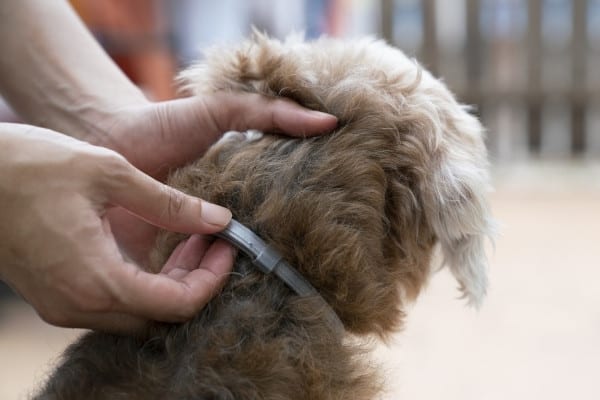
No matter how often you bathe your dog, there’s always a chance that fleas will find their way onto him.
Fleas can cause itching, redness, and discomfort. They can also spread to other pets and humans in the home.
Flea collars are a popular option for controlling a flea problem, and there are many different options on the market, but how safe are they?
Is it safe for a dog with a flea collar to sleep in your bed? Standard flea collars may contaminate your bedding expose you to chemicals if a dog with a flea collar sleeps in your bed. Use a natural flea collar or one that does not contain ingredients that are toxic to humans, such as imidacloprid, flumethrin, tetrachlorvinphos and propoxur.
If your dog wears a flea collar and you are wondering if it is safe for him to wear it while sleeping in your bed, read on to learn more about the risks.
Are Flea Collars Safe?
Veterinarians often recommend flea collars as a way to treat or reduce the number of fleas on your dog. They are designed to be safe for dogs of certain ages and sizes.
There have been reports of flea collars making dogs and people sick. Some dogs can have severe reactions to the chemicals used in flea collars.
Before using flea collars on your dog, make sure you have talked to your vet and understand the possible risks of using a flea collar.
Possible Risks & Side Effects
Flea collars are considered a safe option for controlling fleas and preventing them from making your pet miserable, but they do have some possible risks and side effects that you should know about, especially if your dog sleeps with you at night.
Contamination
While flea collars are made to direct the chemicals that kill fleas onto the skin of the dog, if you sleep with your dog, there is always a chance of contamination when the collar rubs against your own skin or your bedding.
It may also rub off onto other surfaces around your home.
This can leave the chemicals behind on your bed and may allow them to be absorbed into your own skin, which can be hazardous.
Toxic Chemicals
Flea colors contain a safe amount of chemicals to kill fleas on dogs, but those chemicals can be toxic to people and other pets.
Exposure to these chemicals could cause serious illness. Some of the most common toxic chemicals used in flea colors include:
- Imidacloprid
- Flumethrin
- Tetrachlorvinphos
- Propoxur
Ingestion
Pets and even small children may find a way to put a flea collar in their mouths and ingest the chemicals used on them. This can be very dangerous and lead to serious health problems.
Are Flea Collars Toxic to Humans?
Some flea collars do contain ingredients that are toxic to humans. Others only contain natural ingredients which may be safe for humans and even other pets.
Always check the list of ingredients on the flea collar before you put it on your dog.
What Happens If I Touch a Flea Collar?
If you touch your dog’s flea collar, the chemicals that kill and repel the fleas could get on your hands.
Wash your hands as soon as possible to remove the chemicals before they have a chance to make you sick.
Can I Take My Dog’s Flea Collar Off at Night?
If your dog’s collar contains ingredients that are toxic to humans and you want to sleep with your dog, you can remove the collar at night.
Place it in a bag and wash your hands after removing the collar. If the collar does not contain toxic ingredients, it is not necessary to remove it at night.

Symptoms of Flea Collar Poisoning
Some flea collars do contain strong chemicals, and the residue can stay on the dog’s skin for several days or even weeks after the flea collar has been removed.
If the dog licks his fur, he may ingest these chemicals and become ill. Some dogs also find a way to get their flea collars off and eat or chew it, which could also lead to flea collar poisoning.
Here are some symptoms of flea collar poisoning:
- Lethargy
- Muscle spasms
- Weakness
- Abnormal heart rhythm
- Nausea
- Vomiting
- Salivation
- Stomach pain
- Seizures
Safer Alternative: Natural Flea Collars for Dogs
If you aren’t comfortable using flea collars with chemicals, there are some natural flea collars that are just as effective and make a great alternative.
Natural flea collars contain pennyroyal, eucalyptus, peppermint, cedarwood, citronella, thyme, or geraniol (or a combination) which are safe for dogs and humans but effective at keeping fleas away.
They work similar to chemical flea collars, but because the ingredients are nontoxic, they are less likely to make your dog sick.
Do Natural Flea Collars Work?
Natural flea collars are effective at repelling fleas. They can take longer to work than chemical flea collars, but they are much safer for pets and humans.
Best Natural Flea Collar for Dogs: EasyDefense Collar
- FAST ACTING: Provides rapid, on-the-spot protection against fleas and ticks, ensuring your pet's...
- NATURAL AND GENTLE: Crafted from a potent blend of all-natural ingredients, this flea and tick...
If you decide that a natural flea collar is the best option for your dog, consider the EasyDefense Collar.
It contains herbs and natural ingredients that repel fleas and uses almond oil as a base to help carry the product on the skin while also nourishing it.
It effectively repels fleas, ticks, and mosquitoes. It also has a pleasant scent.
Related Questions:
Can You Bathe a Dog With a Flea Collar On?
It is best to remove the flea collar before you bathe your dog, and then reapply it once the dog is clean and the fur is completely dry.
Can Fleas Live in Feather Pillows?
Fleas can lay eggs and live on feather pillows for up to two weeks. If they have a source of blood to feed on (you), they may live longer.
Conclusion
If your dog has a flea problem or if you are looking for a way to prevent a flea problem, a flea collar can be an effective solution.
Research each type and choose the one that you feel is best for your dog. Just be sure you understand the possible risks, and avoid touching the collar whenever possible.
Last update on 2024-04-25 at 00:59 / Affiliate links / Images from Amazon Product Advertising API





